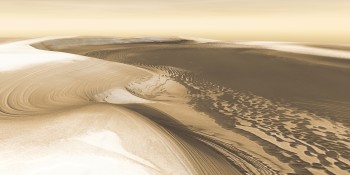Martian Ice Age Record Found
October 11, 2016

Scientists using radar data from NASA’s Mars Reconnaissance Orbiter (MRO) have found a record of the most recent Martian ice age in the planet’s north polar ice cap.
The results, published in the May 27, 2016, issue of the journal Science, agree with previous models that indicate a glacial period ended about 400,000 years ago. The research team included scientists from the Southwest Research Institute, The University of Texas Institute for Geophysics (UTIG) and Washington University.
Scientists use data from MRO’s Shallow Subsurface Radar (SHARAD)
to produce images called radargrams that show vertical slices through the layers of ice and dust that comprise the Martian polar ice deposits. For the new study, researchers analyzed hundreds of such images to look for variations in the layer properties.
On Mars, ice ages occur when–as a result of the planet’s increased tilt the planet’s poles become warmer than lower latitudes. During these periods, the polar caps retreat and water vapor migrates toward the equator, forming ground ice and glaciers at mid-latitudes. As the warm polar period ends, polar ice begins accumulating again, while ice is lost from mid-latitudes. This retreat and regrowth of polar ice is exactly what researchers see in the record revealed by the SHARAD radar images, said planetary scientist Isaac Smith, the study’s lead author.
Smith led the work while at Southwest Research Institute in Boulder,
Colorado. He came up with the idea for the research at the Jackson School of Geosciences, where he received his Ph.D. in 2013.
SHARAD is one of two radar sounders in orbit around Mars, but it is
the only one that approaches the resolution of airborne radar sounders on Earth, said Jack Holt, a study author and research professor at UTIG. The radar allowed researchers to detect and study layering within the polar caps on Mars.
“By applying basic principles of stratigraphy, we can unravel the record
of ice deposition and removal at the poles of Mars,” Holt said.
